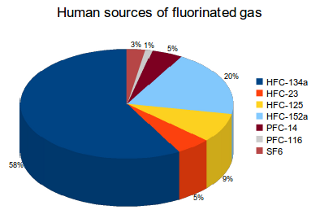Hydrofluorocarbons (HFCs), perfluorocarbons (PFCs), and sulfur hexafluoride (SF6) are the main High Global Warming Potential gases. Many of these gases are 1000, 10 000 even 20 000 times more powerful than Carbon dioxide (CO2) at trapping heat and many can stay in our atmosphere for thousands of years.
Figure 1: Source: The 2010 Assessment of the Scientific Assessment Panel, UNEP.
Source: The 2010 Assessment of the Scientific Assessment Panel, UNEP.
It is important that we discuss what is meant by High Global Warming Potential (HGWP). Global Warming Potentials (GWPs) are used to compare the abilities of different greenhouse gases to trap heat in the atmosphere. Carbon dioxide is used as the base for all the calculations, so its global warming potential is 1. The higher the GWP, the more heat the specific gas can keep in the atmosphere. So the more HGWP gases enter the atmosphere, the faster our climate will change.
As time passes the GWP of a greenhouse gas usually decreases, but as is the case with fluorinated gases since their global warming potential is already very high it takes a very long time for them to lose their ability to trap heat.
The main processes that remove these gases from the atmosphere are chemical destruction by hydroxyl radicals, photolysis and reactions in the mesosphere. Three of the main high global warming potential gases have sinks that act extremely slowly, which is why they have such long lifetimes (more than 1000 years). From the human perspective, the emissions of these gases and the effects that they cause are essentially permanent. If the production of these synthetic gases is not reduced, the long-term increase of global temperatures will continue.
The table below shows the heat trapping ability of the important greenhouse gases after 20 years and 100 years as compared to Carbon dioxide. The reason why we should look at the GWP of greenhouse gases is to highlight the fact that even if there is a small quantity of a specific gas, it doesn't mean we shouldn't take into account the effects that it has on climate change.
Table 1: High Global Warming Potential Gases
| Global Warming Potentials of Greenhouse Gases |
|---|
| (when compared to CO2) | | |
| | | |
| Greenhouse Gas | GWP After 20 Years | GWP After 100 Years |
| Carbon Dioxide | 1 | 1 |
| Methane | 72 | 25 |
| Nitrous Oxide | 289 | 298 |
| HCFC-22 | 5160 | 1810 |
| HFC-23 | 12000 | 14800 |
| HFC-125 | 6350 | 3500 |
| HFC-134a | 3830 | 1430 |
| HFC-143a | 5890 | 4470 |
| CF4 | 5210 | 7390 |
| C2F6 | 8630 | 12200 |
| SF6 | 16300 | 22800 |
Source: Climate Change 2007: the Fourth Assessment Report (AR4), Intergovernmental Panel on Climate Change

